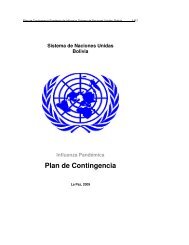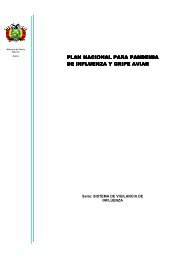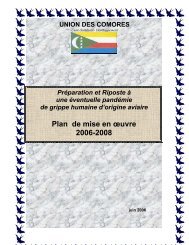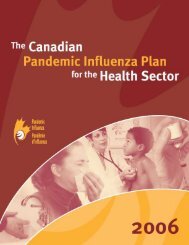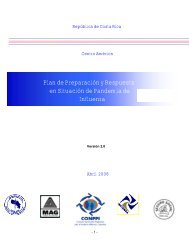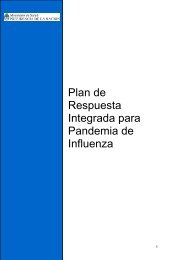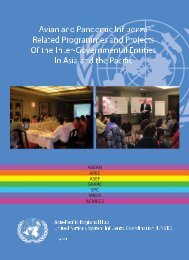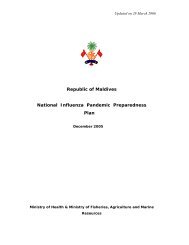Tanzania National Plan (January 2007)[1].pdf - Avian Influenza and ...
Tanzania National Plan (January 2007)[1].pdf - Avian Influenza and ...
Tanzania National Plan (January 2007)[1].pdf - Avian Influenza and ...
You also want an ePaper? Increase the reach of your titles
YUMPU automatically turns print PDFs into web optimized ePapers that Google loves.
<strong>Tanzania</strong> <strong>Avian</strong> <strong>Influenza</strong> <strong>National</strong> Emergency Preparedness & Response <strong>Plan</strong><br />
surfaces. There are 16 H <strong>and</strong> 9 N protein types <strong>and</strong> consequently, many different<br />
combinations of H <strong>and</strong> N proteins are possible. Presently Highly Pathogenic <strong>Avian</strong><br />
<strong>Influenza</strong> (HPAI) viruses in birds are from subtypes H5 <strong>and</strong> H7. There were only three<br />
known influenza A subtypes that affect humans (H1N1, H1N2, <strong>and</strong> H3N2) <strong>and</strong> it is<br />
likely that some genetic parts of these viruses came from birds. Now although the<br />
virus is not very efficient in being transmitted between humans H5N1 seems to have<br />
joined the list of influenza Viruses that also affect man. The capacity of this virus to<br />
also infect humans, has led to a reassessment of the classification <strong>and</strong> management<br />
of such infections.<br />
In general AI virus is infective for almost all, domestic <strong>and</strong> wild avian species.<br />
Infections in monkeys, pigs, ferrets, horses, cattle, cats, seals <strong>and</strong> whales have been<br />
reported. However, although the significance of non-avian species in spreading HPAI<br />
viruses is not well understood, the role of these animals appears to be minimal except<br />
for pigs.<br />
Pigs have special significance in the biology of <strong>Avian</strong> <strong>Influenza</strong>. They can be infected<br />
by H1N1, H3N2, <strong>and</strong> H1N2 that are also infectious to humans <strong>and</strong> H4N6 <strong>and</strong> H5N1<br />
that are infectious to Birds. In this regard these animals can facilitate development of<br />
new types of viruses.<br />
AI virus occurs, in one or a number of its many serotypes, in all continents where<br />
research has been carried out. Internationally, 12 outbreaks of HPAI were recorded to<br />
between 1955 <strong>and</strong> 1994 following the recognition in former year that fowl plague, or<br />
HPAI, was caused by an influenza virus. Since 1994, there have been 25 further<br />
outbreaks, most of which occurred from 2000 onwards. Table 2 shows the dates <strong>and</strong><br />
locations of these outbreaks.<br />
Table 2 Outbreaks of highly pathogenic avian influenza, 1995–2006<br />
LOCATION DATE VIRUS SUBTYPE HUMAN INFECTION<br />
Pakistan 1995, 2004, 2006 H7N3, H5N1 Recorded<br />
Mexico 1995 H5N2 Not recorded<br />
Italy 1997, 1999 H5N2, H7N1 Not recorded<br />
Hong Kong 1997, 2001, 2002,2004 All H5N1 Recorded 1997<br />
Australia (NSW) 1997 H7N4 Not recorded<br />
Chile 2002 H7N3 Not recorded<br />
Netherl<strong>and</strong>s 2003 H7N7 Recorded<br />
Germany 2003 H7N7 Not recorded<br />
Belgium 2003 H7N7 Not recorded<br />
South Korea 2003 H5N1 Not recorded<br />
Japan 2004, 2006 H5N1 Not recorded<br />
Vietnam 2004 H5N1 Recorded<br />
Thail<strong>and</strong> 2004 H5N1 Recorded<br />
Laos 2004 H5N1 Not recorded<br />
Cambodia 2004, 2005, 2006 H5N1 Recorded<br />
Indonesia 2004 H5N1 Not recorded<br />
China 2004,2005, 2006 H5N1 Recorded<br />
Malaysia 2004 H5N1 Not recorded<br />
United States (Texas) 2004 H5N2, H7N2, H2N2 Not recorded<br />
Canada 2004 H7N3 Recorded<br />
South Africa 2004 H5N2 Not recorded<br />
Egypt 2005 H5N2 Not recorded<br />
Philippines September 2005 H5N1 Not Recorded<br />
10


![Tanzania National Plan (January 2007)[1].pdf - Avian Influenza and ...](https://img.yumpu.com/36423433/10/500x640/tanzania-national-plan-january-20071pdf-avian-influenza-and-.jpg)
